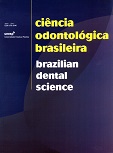Efeitos de Coffea arabica sobre a aderência de Streptococcus mutans à superfície de vidro
DOI:
https://doi.org/10.14295/bds.2003.v6i3.617Abstract
A proposta deste estudo foi avaliar os efeitos de diferentes soluções de café na aderência de S. mutans à superfície de vidro. As soluções de café foram preparadas com água destilada contendo fluoreto (1ppm), totalizando 5 grupos experimentais (n=20): 1) solução de café a 8%; 2) solução de café a 16%, ambos com água fervida e escoada através do pó (solução de café simples); 3) solução de café a 8%; 4) solução de café a 16%, ambos com água fervida juntamente com o pó e depois filtrada (solução de café fervido) e 5) controle. Todas as diferentes soluções de café e controle foram colocadas em 20 tubos de ensaio contendo BHI desidratado e 10% de sacarose. Bengalas de vidro de tamanho padronizado foram inseridas em cada um dos tubos e a seguir esterilizados. S. mutans GS 5 (105 células/mL) foram transferidos para os tubos, permanecendo em microaerofilia (5% de CO2) a 37º por 1h30min. Após esse período, as bengalas foram transferidas para tubos com tampão fosfato, agitadas e a suspensão diluída e semeada em placas com ágar BHI acrescido de 10% de sacarose. Após 48h de incubação a 37ºC/ 5%CO2, determinou-se o número de UFC/mL para cada grupo. Os resultados foram analisados estatisticamente pelo método de ANOVA (a = 5%) e teste de Tukey. Pôde-se concluir que a solução de café simples e a solução de café fervido reduziu significantemente a aderência de S. mutans GS 5, sendo a solução de café fervido a 16% mais efetiva.Downloads
Downloads
Published
How to Cite
Issue
Section
License
Brazilian Dental Science uses the Creative Commons (CC-BY 4.0) license, thus preserving the integrity of articles in an open access environment. The journal allows the author to retain publishing rights without restrictions.
=================




























